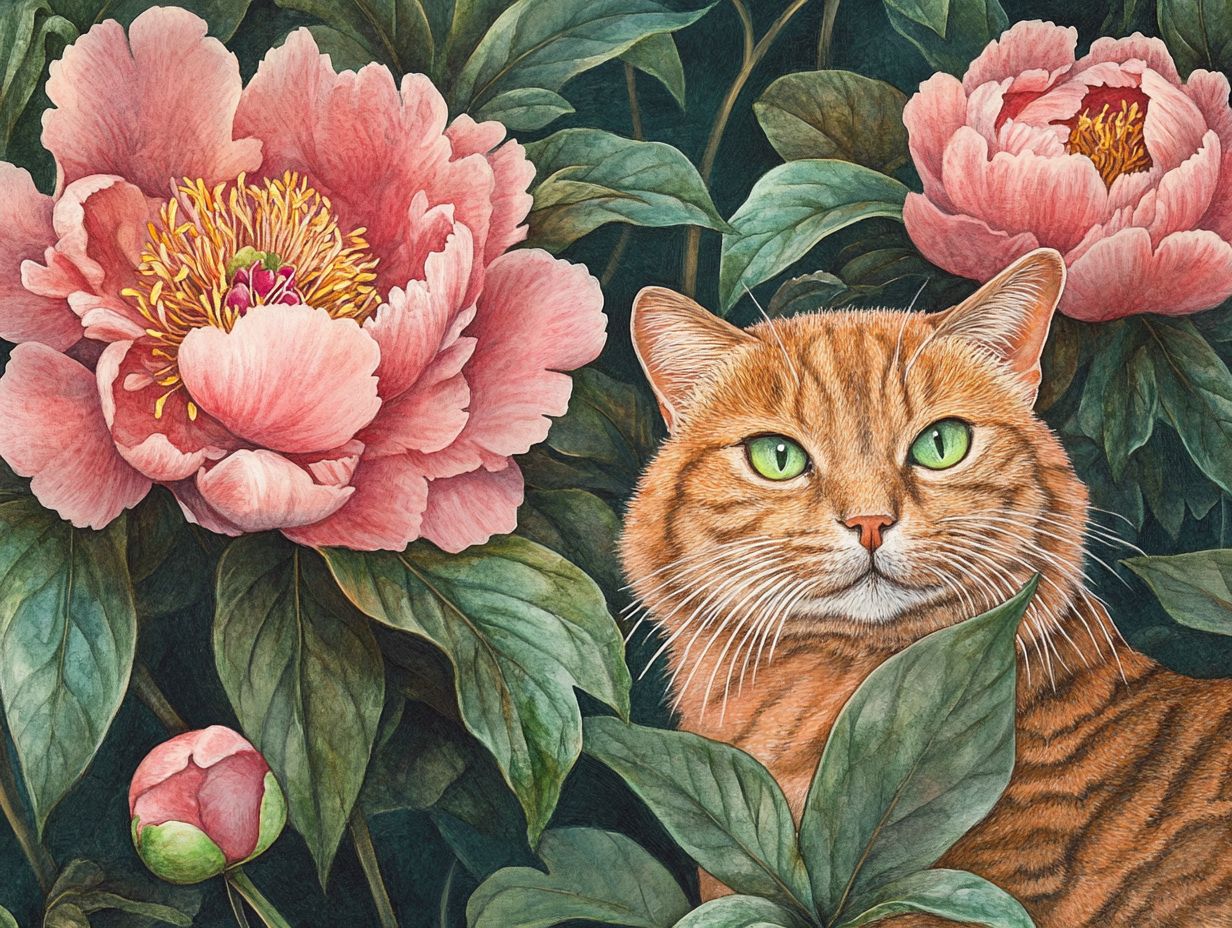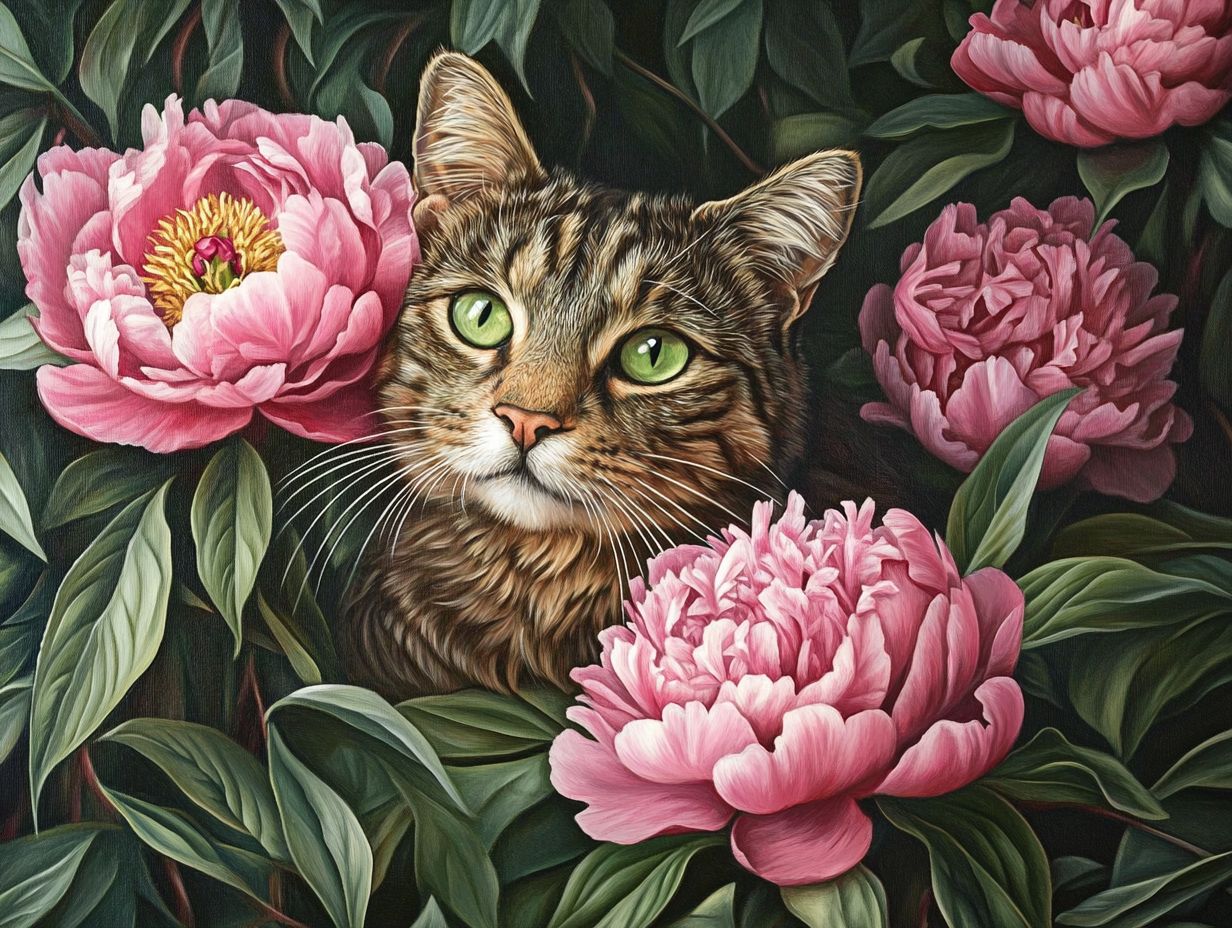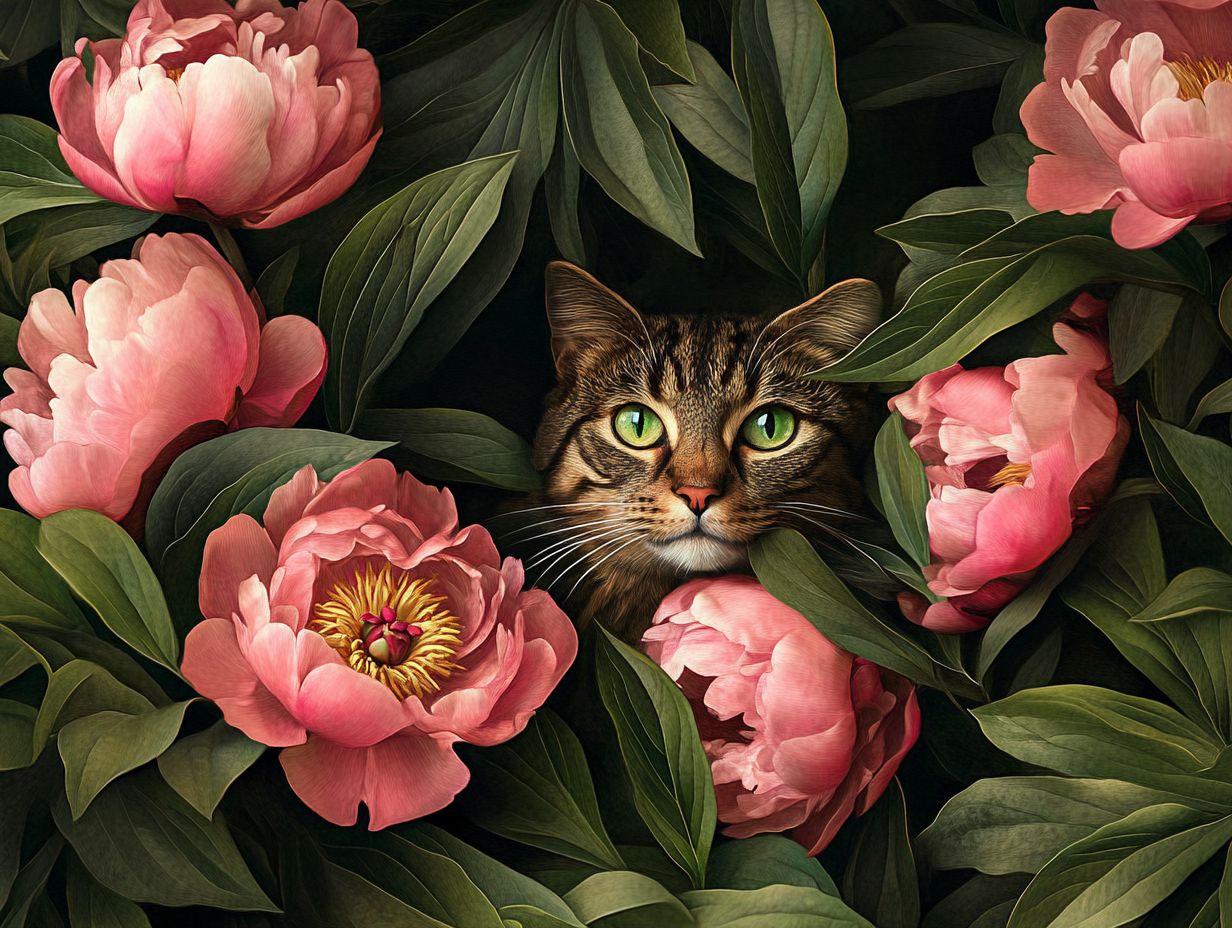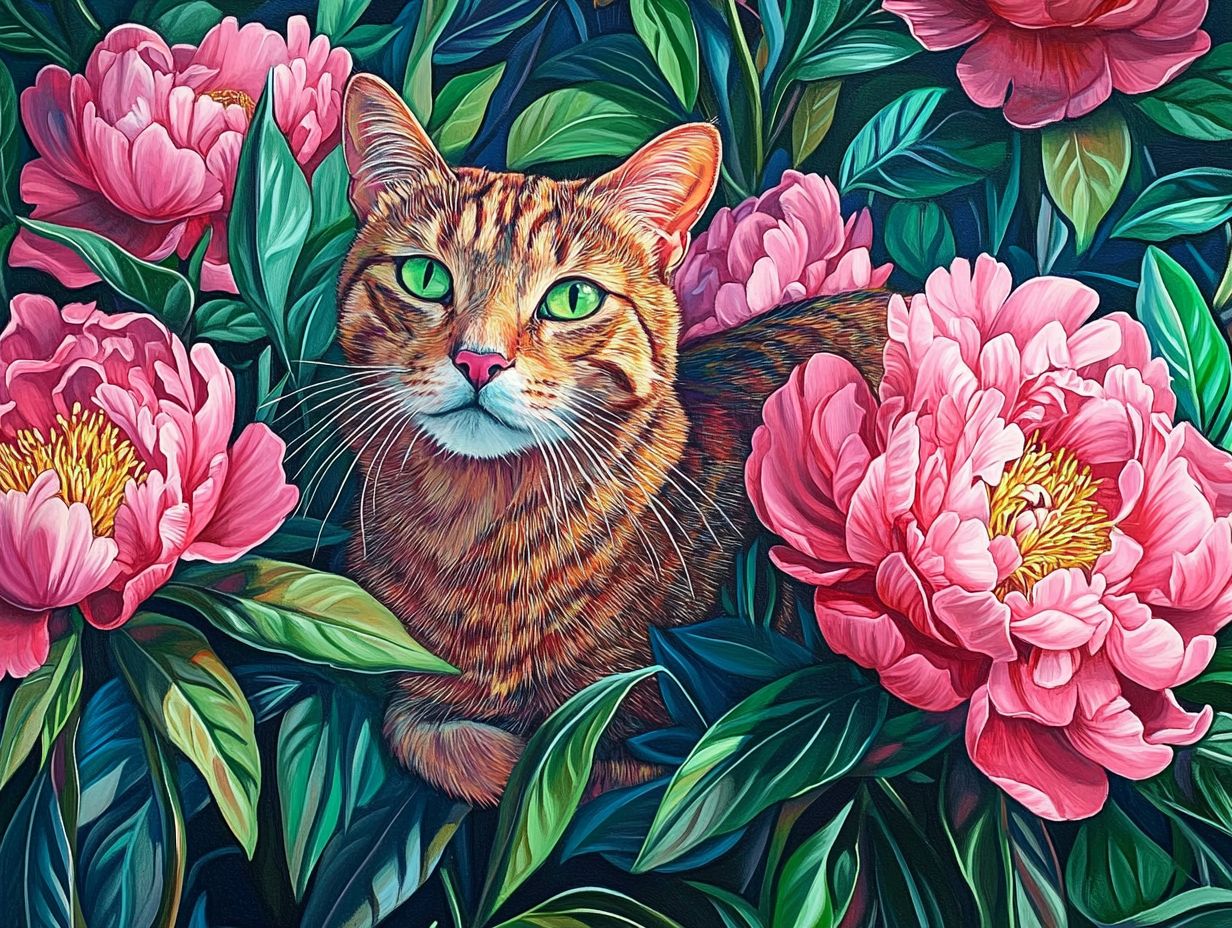Peonies are beautiful flowers that can add vibrant color to any garden, but if you’re a cat owner, you might have concerns about the safety of plants like these, which are toxic to cats. According to the ASPCA, peonies can cause adverse effects if ingested by pets.
This piece explores the various types of peony plants, their potential toxicity to cats and dogs, and the common symptoms of peony poisoning. It also shares practical tips to keep your feline friend safe around these beautiful blooms, emphasizing the importance of keeping away pets from potentially harmful plants.
Read on to ensure your garden remains a safe haven for your beloved pets, and learn how to incorporate non-toxic alternatives like Catnip and Wheatgrass!
Key Takeaways:

- Peonies are toxic to cats, as they contain substances that are harmful to them.
- Common symptoms of peony poisoning in cats include vomiting, diarrhea, and difficulty breathing.
- If your cat ingests peonies, contact your veterinarian immediately and monitor their symptoms. Inducing vomiting, if recommended by veterinary assistance, may also be necessary.
What Are Peonies?
Peonies (Paeonia officinalis) are flowering plants belonging to the Paeoniaceae family. These perennial herbs or shrubs are highly valued for their stunning blooms and sweet fragrances.
Available in a wide range of sizes and colors, they are frequently used as cut flowers and in garden landscapes. Additionally, peonies like Paeonia officinalis are known for their hardiness and belong to the Paeoniaceae family.
What Are the Different Types of Peonies?
There are several types of peonies, including herbaceous peonies, tree peonies, and intersectional peonies. Each category possesses distinct characteristics and growth requirements.
Herbaceous peonies are bushy and feature vibrant green foliage that dies back in winter, making them ideal for garden beds where seasonal change is appreciated. However, if you have cats, it’s important to consider their safety. For more information, check out this guide on whether peonies can be harmful to cats.
Tree peonies, on the other hand, are woody plants that thrive in sunny areas with well-drained soil, showcasing large and beautiful blooms.
Intersectional peonies are hybrids of the other two types, combining their strengths. They are diverse in color and exhibit robust growth.
Are Peonies Harmful to Cats?
Peonies are toxic to cats and other pets. Pet owners should be aware of the dangers associated with peonies if they have or are considering getting a pet. Understanding peony toxicity can help them create a safer environment in their homes. For more information, check out Can Peonies Be Harmful to Cats? Pet Safety Advice.
What Parts of the Peony Plant Are Toxic to Cats, Dogs, and Horses?
All parts of the peony plant, including its flowers, leaves, and roots, contain toxic components that can pose health risks to cats, dogs, and horses if ingested. Specifically, the plant contains a compound known as paeonol, which is primarily found in the roots and bark and can lead to a range of adverse effects. Additionally, the leaves and flowers contain various alkaloids and saponins that contribute to the plant’s toxicity.
If a cat consumes any part of the peony, pet owners should be vigilant for signs of poisoning, such as vomiting, diarrhea, and noticeable lethargy. These gastrointestinal symptoms may appear within a few hours of ingestion. In severe cases, the cat could exhibit changes in heart rate or have difficulty breathing, necessitating immediate veterinary attention.
What Happens if a Cat Ingests Peonies?

Cats and dogs that consume peonies may experience peony poisoning, which is marked by gastrointestinal distress and can become serious if not promptly treated by a veterinarian.
Mild Symptoms:
- Vomiting
- Diarrhea
Moderate Symptoms:
- Depression
- Anorexia
- Hypersalivation
Severe Symptoms:
- Changes in heart rate
- Difficulty breathing
- Seizures
For cats, the most common symptoms include vomiting, diarrhea, depression, anorexia, and hypersalivation. Dogs that come into contact with the flower may exhibit similar symptoms, often accompanied by abdominal pain and other signs of gastrointestinal distress.
First Aid Steps for Suspected Poisoning
If you suspect your cat has ingested peonies, follow these first aid steps:
- Contact your veterinarian immediately.
- Do not induce vomiting unless instructed by a veterinary professional.
- Monitor your cat closely for any symptoms.
Prevention Tips
To keep your pets safe from peony toxicity, consider the following tips:
- Keep peonies out of reach of pets.
- Use barriers such as fences or plant cages to protect your garden.
- Consider planting non-toxic alternatives that are safe for pets.
Addressing Common Misconceptions
Many people believe that all flowers are safe for pets; however, it is crucial to verify plant safety. Peonies, despite their beauty, are dangerous for pets.
Benefits of Peonies
Despite the risks, peonies can offer numerous benefits, such as their stunning aesthetic appeal and role in enhancing garden landscapes.
Special Considerations
Kittens and senior cats may be more sensitive to the effects of peony ingestion, and pet owners should exercise extra caution during the blooming season when these flowers are more abundant.
For emergencies, contact the ASPCA Animal Poison Control at (888) 426-4435.
Note: This article was last reviewed on [Insert Date]. The content is for informational purposes only and is not a substitute for professional veterinary advice.
If you suspect that your pet has been poisoned by these beautiful yet hazardous flowers, it is crucial to take them to your local emergency veterinarian as soon as possible.
What Are the Symptoms of Peony Poisoning in Cats?
Peonies are considered mildly toxic to cats, and the toxic compounds found in the plant include saponins and calcium oxalate crystals. Symptoms of peony poisoning in cats can range from mild to severe and may include:
- Gastrointestinal issues: vomiting, diarrhea, and abdominal pain.
- Neurological symptoms: lethargy or unusual behavior.
- Cardiovascular effects: increased heart rate or respiratory distress.
Immediate veterinary treatment is often necessary to address these symptoms effectively.
How to Keep Your Cat Safe Around Peonies
Pet owners should take preventive measures to ensure the safety of their cats by keeping them away from peonies and other harmful plants.
1. Avoid Planting Peonies in Your Garden and Use Peat-free Compost
The best way to protect cats is to avoid planting peonies in the garden and to select other flora that is not harmful to them. Pet-friendly gardens are essential for cat owners, as they provide a safe space for their cats to roam and enjoy the outdoors.
By planting non-toxic flowers such as cat grass, spider plants, African violets, and bamboo palms, a cat-friendly environment can be created without jeopardizing the safety of the pets. Thoughtful garden planning that prioritizes animal safety ensures that people can cultivate a part of the ecosystem that is safe for both humans and animals.
2. Keep Cut Peonies Out of Reach
When bringing cut peonies into the home for floral arrangements, it’s essential to keep them out of reach of curious cats to prevent accidental ingestion. While these flowers can enhance an indoor space, it’s important to recognize the potential risks they pose to pets.
Arrangements should be placed on high shelves or in areas that are inaccessible to pets. Using a heavy vase can help minimize the risk of spills, which may attract pets to the water or fallen petals.
As with any new or unfamiliar object in the house, it’s wise to monitor your pet’s behavior around floral arrangements, as their natural curiosity may lead them to investigate these beautiful yet potentially hazardous plants. If you notice any signs of distress, such as vomiting or unusual lethargy, seek veterinary care immediately.
3. Educate Yourself on Other Toxic Plants for Cats

Understanding which plants are toxic to cats is essential for pet owners to maintain a safe home environment. This knowledge not only helps create a healthy living space but also protects beloved cats from discomfort and illness.
Many common houseplants, such as lilies, daffodils, tulips, poinsettias, and philodendrons, can be easily overlooked, yet they pose serious risks to a cat’s well-being. For instance, ingesting lilies can lead to kidney failure, while philodendrons can cause oral irritation, vomiting, and difficulty swallowing.
By educating themselves about these plants and their effects, caregivers can recognize signs of toxicity, such as excessive drooling and lethargy, which is crucial for early intervention that can save lives. A thorough understanding of these hazards enables pet owners to make informed decisions and safeguard their furry friends from harmful plants.
What to Do if Your Cat Ingests Peonies
If you suspect that your cat has ingested peonies, it is crucial to take immediate action to ensure their safety, which includes getting them to a veterinarian or emergency care facility as soon as possible.
1. Contact Your Veterinarian Immediately
The first step in addressing potential peony poisoning is to contact your veterinarian as soon as possible for guidance and support. This is crucial for your pet’s safety and helps to calm the situation while ensuring prompt action is taken.
The veterinarian will likely want to know details about your pet’s condition, including any symptoms they are exhibiting, how much peony they consumed, and when the incident occurred. When speaking with the veterinarian, be prepared to provide information about your pet’s medical history and any other substances they may have ingested.
This information will help expedite the consultation and increase the likelihood that your pet can receive the necessary treatment quickly. Expect that your pet will undergo a thorough assessment, and possibly diagnostic tests, to evaluate their health status.
Remember, a phone call could be the difference between life and death, so be ready to advocate for your pet’s needs whenever possible.
2. Monitor Your Cat’s Symptoms
Keep a close eye on your cat’s behavior and any symptoms they display. If symptoms worsen or new ones appear, contact your veterinarian again.
First Aid and Treatment Instructions:
- Do not induce vomiting unless instructed by a veterinarian.
- Keep your cat calm and comfortable while you prepare for the vet visit.
- Gather any relevant information, such as the type of peony ingested and the amount.
Possible treatments a veterinarian may use include:
- Administering activated charcoal to prevent further absorption of toxins.
- Intravenous fluids for hydration and to flush out toxins.
- Medications to control symptoms such as vomiting.
Prevention and Safety Measures:
- Consider using barriers to keep peonies and other toxic plants out of reach.
- Choose non-toxic alternatives like sunflowers or zinnias for floral arrangements.
Consult your veterinarian for specific recommendations tailored to your pet’s needs.
Common Misconceptions:
Many believe that peonies are safe for pets because they are not as well-known as other toxic plants. However, it is essential to recognize that even mildly toxic plants can pose risks to inquisitive cats.
Special Considerations:
Kittens, senior cats, or those with existing health issues may be more susceptible to the effects of peony exposure. Always take extra precautions during the blooming season when these flowers are more likely to be brought into the home.
For more information on plant safety and toxic plants for cats, consult a veterinarian or visit the ASPCA Animal Poison Control website.
Disclaimer: This information is not a substitute for professional veterinary advice. Always consult your veterinarian regarding your pet’s health.
Last Reviewed: October 2023. Content is regularly reviewed to ensure accuracy as new research becomes available.
While waiting for veterinary care, it is important to keep track of your cat’s symptoms so that you can provide the veterinarian with the most relevant information. Close observation of your cat’s behavior, appetite, and energy level can help you detect small changes that may be significant indicators of their well-being.
For instance, if your cat becomes more lethargic than usual, stops eating or drinking, or exhibits increased vocalization or hiding, you should closely note these changes. Daily journaling can be very beneficial; record any unusual behaviors, changes in litter box habits, or physical symptoms such as vomiting or diarrhea. These details will facilitate a more accurate and prompt diagnosis, leading to more effective treatment.
Keeping notes of your observations ensures that the veterinarian has all the necessary information to assess your cat’s condition.
3. Induce Vomiting if Recommended by Your Veterinarian and Contact APCC
If your veterinarian recommends it, inducing vomiting may be necessary to prevent further absorption of toxins from ingesting peony plants. This procedure should be performed within a specific timeframe, typically within two hours of eating the plant, to ensure its effectiveness. It is crucial for pet owners to understand the potential dangers and signs of poisoning.
Inducing vomiting can lead to additional gastrointestinal symptoms of distress or complications that require monitoring by the veterinarian. Methods involving hydrogen peroxide or other veterinary-approved substances will be recommended for safe vomiting induction. It is important to avoid home remedy methods that may pose additional risks to your pet’s health. For those concerned about toxic plants, you can read more about whether peonies can be harmful to cats and dogs for essential pet safety advice.
Always follow your veterinarian’s instructions precisely, especially when dealing with toxic plants like Paeonis officinalis from the Paeniaceae family.
Frequently Asked Questions

Can Peonies Be Harmful to Cats?
Yes, peonies can be harmful to cats and dogs if ingested, due to their toxic components, such as paeonol. Source: ASPCA
Toxicity Level: Toxic
- Paeonol
What parts of the peony plant are toxic to cats?
All parts of the peony plant, including the leaves, stems, and beautiful flowers, contain toxins that can be harmful to cats and dogs.
What are the symptoms of peony poisoning in cats?
- Mild: Vomiting, diarrhea
- Moderate: Lethargy, difficulty breathing
- Severe: Severe gastrointestinal distress, additional complications
How can I prevent my cat from being exposed to peonies?
To prevent your cat from being exposed to peonies, it is best to avoid having them in your home or garden. If you do have peonies, make sure they are kept in an area that is inaccessible to your cat, and keep away pets from floral arrangements containing toxic plants.
What should I do if my cat has ingested peonies?
Immediate veterinary care is crucial. If your cat has ingested peonies, it is important to seek immediate veterinary care. Veterinary assistance is crucial for emergency care. Do not try to induce vomiting or give any home remedies without consulting a veterinarian first.
Step-by-step First Aid Guide:
- Contact your veterinarian immediately.
- If advised, induce vomiting as per your veterinarian’s directions.
- Monitor your cat for any changes in behavior or health.
Are there any safe alternatives to peonies for my cat-friendly garden?
Yes, there are many beautiful and safe plants that you can include in your cat-friendly garden:
- Catnip
- Catmint
- Cat grass
- Spider Plants
- African Violets
- Wheatgrass
It is always best to research the toxicity of any plant before introducing it to your cat’s environment.
Disclaimer: The information provided is for educational purposes and should not replace professional veterinary advice.
Please stay updated on the latest research regarding pet safety and toxic plants, and consult your veterinarian for the best care practices. Last reviewed: .